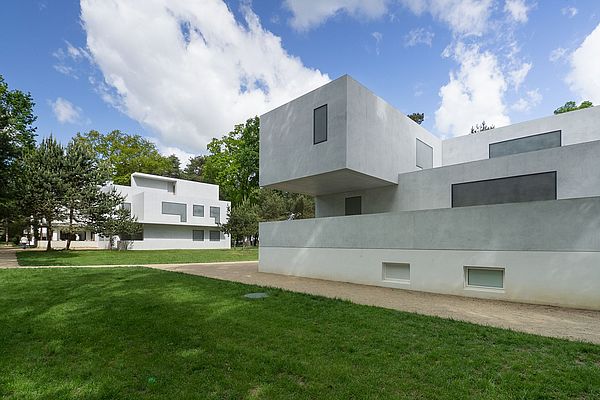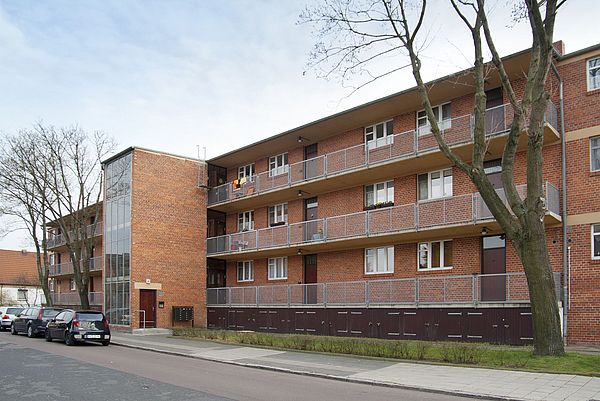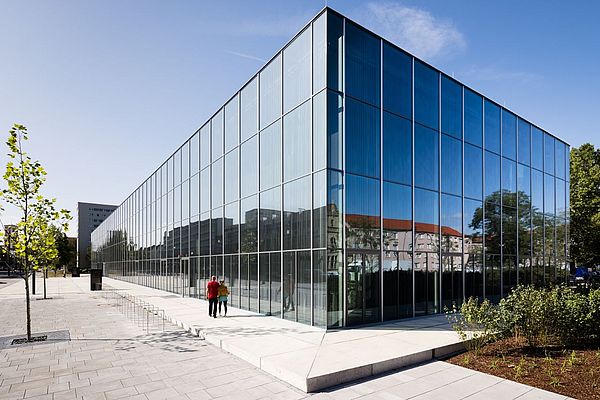Bauhaus Dessau Foundation
The Bauhaus Dessau Foundation has its headquarters in the historic Bauhaus building. As an artistic and scientific foundation, it cultivates and communicates the ideational and architectural heritage of the Bauhaus in Dessau.

Headline
The Bauhaus in Dessau experienced its most successful period from 1925 to 1932. The liberal spirit of optimism in the city offered the Bauhäusler many opportunities for development – as a university with reformed education, as a production site for serially manufactured product design, as a place to experiment with a new kind of theatre and stage understanding, and of course also for architecture and collective living together.

Headline
Much of this time has been handed down until today and can be found in Dessau. The Bauhaus building with its workshop wing, stage and refectory, the Masters’ Houses as a colony of artists, the Dessau-Törten housing estate with the consumer building and the porticoed houses for social housing, as well as the Kornhaus restaurant and the historic employment office. Each of these buildings tells the story of an avant-garde basic understanding of a modern society.

Headline
The Bauhaus Dessau Foundation was established in 1994 as an artistic and scientific foundation. It works historically reflexively and at the same time, in exhibitions, symposia, publications and the stage programme, explores the current potential that the Bauhaus legacy offers for the 21st century. It works historically reflexively and at the same time, in exhibitions, symposia, publications and the stage programme, it simultaneously inquires into the current potential that the Bauhaus legacy offers for the 21st century. A wide variety of scientific and artistic formats address designers, artists, architects, researchers and students from all over the world.
A highlight of the year is the traditional Bauhaus Festival, which cooperates with many renowned art, design and film schools. In addition, the Foundation is responsible for the preservation of many historical Bauhaus buildings in Dessau, which are considered its largest exhibition objects. The Bauhaus building, the Masters’ Houses and the Laubenganghäuser (arcades) are part of the UNESCO World Cultural Heritage. These architectural icons of classical modernism attract over 100,000 visitors per year.

Bauhaus Museum Dessau
In September 2019, the Bauhaus Museum Dessau opened its doors. The Dessau collection is presented here comprehensively for the first time. It comprises over 50,000 objects and is thus the second largest Bauhaus collection in the world. Records from lessons, drafts and prototypes from the workshops shape its profile. This is why the exhibition “Versuchsstätte Bauhaus. The Collection” at the Bauhaus Museum Dessau does not focus on the generally known design icons and their masters, but rather on the school and its students: the everyday life of learning and teaching between free design and industrial prototype, artistic experiment and economic pressure, educational institution and emancipation space.

Contact
Stiftung Bauhaus Dessau / Bauhaus Dessau Foundation
Gropiusallee 38
06846 Dessau-Roßlau
Opening times:
Bauhaus Building and Masters’ Houses
Mon–Sun, 10–17 h (March–Oct)
Tue–Sun, 10–17 h (Nov–Feb)
Consumer building
daily, 10–17 h (Mar–Oct)
(closed Nov–Feb)
Bauhaus Museum Dessau
Tue–Sun, 10–18 h (Mar–Oct)
Tue–Sun, 10–17 h (Nov–Feb)
T +49 (0)340 – 65 08 250
E service(at)bauhaus-dessau.de
www.bauhaus-dessau.de
Headline
Thematic chapters, for example, illustrate in depth the mutual learning between teachers and students, such as Marianne Brandt and László Moholy-Nagy or Gunta Stölzl and Paul Klee. The Bauhaus as a versatile 'tasting ground’, as a cooperation partner for industry and as an active communicator is described by the presentation of the development process of selected Bauhaus objects.
The ground floor of the Bauhaus Museum Dessau is a new cultural Bauhaus site in the Zentrum Dessau. Designed as an open stage, the space is also used as such. As a new experimental venue for performative and discursive formats, it complements and extends the programme on the Bauhaus stage in the historic Bauhaus building.